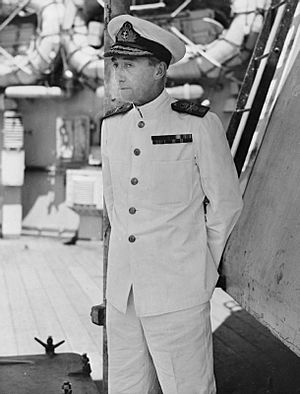Bernard Rawlings (Royal Navy officer) facts for kids
Quick facts for kids
Sir Bernard Rawlings
|
|
|---|---|

Vice Admiral Rawlings during the Second World War
|
|
| Born | 21 May 1889 St Erth, Cornwall, England |
| Died | 30 September 1962 (aged 73) Bodmin, Cornwall, England |
| Allegiance | United Kingdom |
| Service/ |
Royal Navy |
| Years of service | 1904–1946 |
| Rank | Admiral |
| Commands held | Eastern Mediterranean (1943–44) West Africa Station (1943) Force B (1941) 7th Cruiser Squadron (1941) 1st Battle Squadron (1940–41, 1944–45) HMS Valiant (1939–40) HMS Delhi (1932–34) HMS Curacoa (1932) HMS Active (1931–32) |
| Battles/wars | |
| Awards | Knight Grand Cross of the Order of the British Empire Knight Commander of the Order of the Bath Mentioned in dispatches (2) Legion of Merit (United States) Order of George I (Greece) War Cross (Greece) |
Sir Henry Bernard Hughes Rawlings (born May 21, 1889 – died September 30, 1962) was a very important officer in the Royal Navy, which is the United Kingdom's navy. He became an Admiral and played a big role during the Second World War, especially in the eastern part of the Mediterranean Sea.
Contents
Bernard Rawlings was born in St Erth, a village in Cornwall, England, on May 21, 1889. He went to Stubbington House School before joining the Royal Navy in 1904. This was the start of a long and successful career at sea.
Early Years and World War I
Rawlings served in the First World War. After the war ended, he worked for the Foreign Office, which deals with international relations. He also took part in military missions in Poland.
He then commanded several ships. These included the destroyer Active and the cruisers Curacoa and Delhi. In 1936, he became a Naval Attaché in Tokyo. This meant he represented the British Navy in Japan.
World War II: A Key Leader
When the Second World War began, Rawlings was ready for action. He first commanded the battleship Valiant. Battleships are very large warships with powerful guns.
From 1940, he led the 1st Battle Squadron. He was promoted to Rear-Admiral in January 1942. Later that year, he became the Assistant Chief of Naval Staff.
In 1943, he was made Flag Officer, West Africa. This meant he was the top naval commander in that region. He was promoted to Vice-Admiral in November of that year.
Leading in the Mediterranean and Pacific
In December 1943, Rawlings became the Flag Officer, Eastern Mediterranean. This was a very important role during the war. He then became the second-in-command of the British Pacific Fleet. His main ship was HMS King George V.
From 1944, he commanded British Task Force 57 in the Pacific Ocean. He led this force through major battles, including the Battle of Okinawa in 1945. This was a very tough fight.
Admiral Rawlings retired from the Royal Navy in 1946. He passed away in Bodmin, Cornwall, England, on September 30, 1962.

